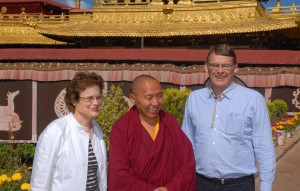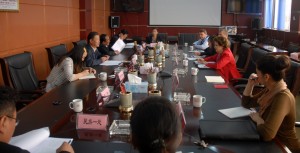
Frances Adamson, Australian Ambassador to China, with a Tibetan monk and Mr Bunten at Jokhang Temple in Lhasa, August 2013
Photo: china.embassy.gov
Australian diplomat Frances Adamson, who is based in Beijing, has been to Tibet for a four day visit at the end of August. This trip comes almost 18 months after entry into Tibet was requested by Australian Foreign Minister Bob Carr to “investigate the grievances that had led to an appalling spate of self immolations.” Diplomats and journalists are usually not granted access into the Tibetan Autonomous Region by Chinese authorities.
Adamson said that she “clearly and directly conveyed the Australian government’s views on the human rights situation in Tibet,” and that she “made the point that […] open and regular access to the Tibetan Autonomous Region for the media, as well as for Australian diplomats [is called for].” During her stay in Tibet, Adamson visited Naidong County and Lhasa. She discussed the development taking place in Tibet, and examined Tibetan agriculture- and health-centered projects funded by the Australian government.
Though the Chinese government has in the past allowed ambassadors from countries such as the United States, Canada and New Zealand access into Tibet, it specifically restricts access into the Sichuan region where the majority of the self-immolations have taken place.
The director of modern Tibetan studies at Columbia University has said that the “[Chinese] authorities were keen to highlight Tibet’s economic progress and tourism potential—and that tightly controlled visits were one factor in the charm offensive.”
Though many see the Chinese government’s move of giving access into Tibet as a sign that their new leadership is trying to ease the conflicts in the region, human rights activist groups have expressed concern that the Chinese government is confident that it can control and stage manage the visits, driving attention away from the self-immolations and diverting criticism from western governments. These groups have cautioned that the Tibet Autonomous Region exists under de facto martial law, and that China is granting access as a way to manipulate journalists into being used for the purpose of propaganda.





 Print
Print Email
Email